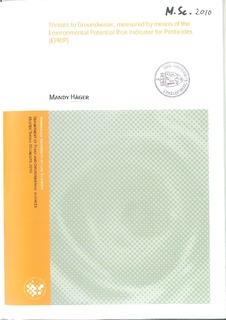| dc.description.abstract | The pollution and depletion of our groundwater resources is one of the biggest threats to our society. In recent times, groundwater has been facing an increasing pressure from intensive land use (e.g. agriculture, industry, forestry, etc) and overconsumption by people. In many areas of the world the quantity and quality of groundwater aquifers has been negative affected; causing harm to both humans and the environment.
This paper has been written in connection with the Genesis project, which aims to identify threats to groundwater and groundwater dependent ecosystems, to increase the knowledge in relation to groundwater systems, to develop new tools and indicators for a better groundwater management and to give a new scientific foundation for the revision of the groundwater directive (GWD).
The main focus of this thesis lies on the risk assessment, in relation to groundwater contamination caused by pesticides, under Norwegian conditions. Here, a risk evaluation was undertaken by means of the risk indicator model (EPRIP); and for the area Grue, a small municipality located in the south-eastern part of Norway. Simulations were done for potato and spring wheat production, a total of 9 different soil types and 44 pesticides. Active ingredients were then grouped in (1) risk classes according to the final EPRIP score and (2) risk classes according to predicted environmental concentration in groundwater and hydrological class. The results were so compared with field data and risk classifications obtained by MACRO_GV (for the same area), in order to validate the outcomes and to identify whether EPRIP is suitable for Norwegian conditions or not.
Due to large difference between the predicted environmental concentrations (PEC) in groundwater, achieved by MACRO_GV and EPRIP; calibrations (in relation to water table thickness and water table depth) were undertaken for last named model. This has been done in order to ensure a better foundation for the comparison of the two models, by reason of the different approaches they use for the calculation of the PEC in groundwater. Due to limited time, four active ingredients were chosen in order to monitor the effects of the calibration; those were MCPA, metribuzin, tribenuron-methyl and rimsulfuron. Parameters were adjusted gradually; meaning that simulations were done for (1) a water table thickness of 0.3 m, (2) a water table depth of 1 m, and (3) a change in both parameters simultaneously.
Risk evaluations undertaken for potato and spring wheat production, by means of the risk indicator model (EPRIP), indicated that the agreement, with MACRO_GV and field data, was best when simulations were accomplished with calibrated values. The modification of both parameters simultaneously gave a good consistency between EPRIP and MACRO_GV, in respect to metribuzin and MCPA. In contrast, the agreement for low dose pesticides (rimsulfuron and tribenuron-methyl) was not as good. Risk classification of MCPA and metribuzin were also reflected by findings in the field.
Due to the lack of simulation results, it is difficult to give a clear answer as to whether output values of EPRIP are reliable and as to whether the model is suitable for Norwegian conditions or not. More simulations should be carried out in order to support the findings in this study and to give a more specific answer. | no_NO |
